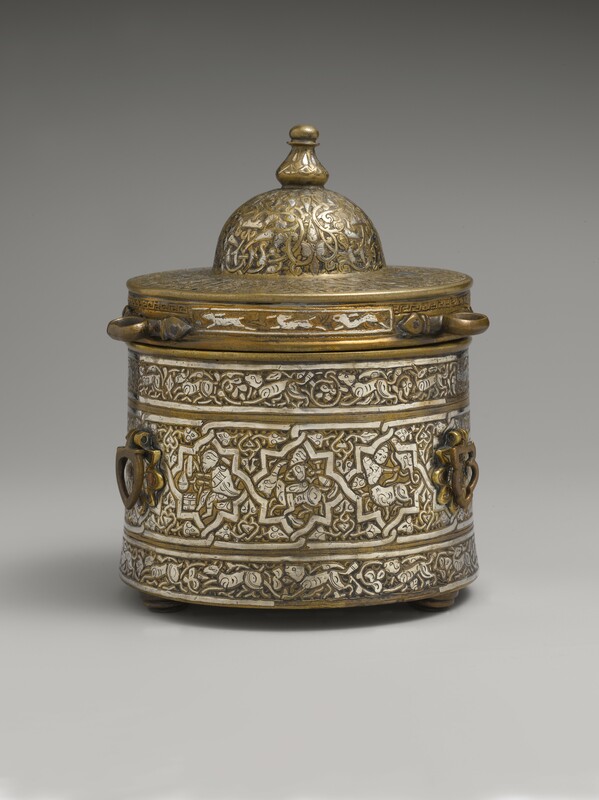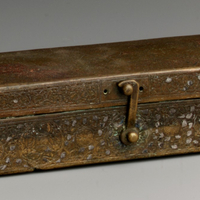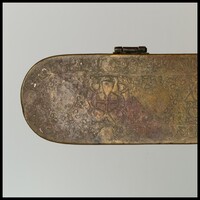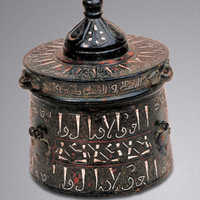Islamicate pen boxes and inkwells
Date:
Thirteenth century
Location or Findspot (Modern-Day Country):
Iran
Dimensions:
Pen box, AKM609, 19.4 × 4.5 cm;,
Pen box, MMA 89.2.194, 6.4 × 22.5 x 4.3 cm;,
Inkwell, AKM604, 10.4 × 8.5;,
Inkwell, MMA 59.69.2, 14.9 × 11.6 cm
Description:
(Sura 96) of the Qur'an refers to God teaching humanity by means of the pen, and calligraphy was prized across the Islamicate world. Pen cases and inkwells could therefore be items of great value. Usually made of brass or another copper alloy, they were often richly inlaid with silver or other materials, and many bear inscriptions that reveal ownership by government officials.
The function of a pen box was to hold the tools of a scribe: reed pens with different-size nibs and a knife to keep them sharp. Two such boxes are shown here. The one in the Aga Khan Museum has nonfigural ornament, made by hammering silver wire into the brass to create cells for floral and geometric inlay. Three elaborate medallions adorn the lid. The example in the Metropolitan Museum of Art is unusual in having three astrological roundels on the lid. These show the moon flanked by Jupiter and Venus, selections presumably dictated by the owner's natal horoscope. There are additional medallions inside the box, and on the outside are images of musicians and drinkers—typical courtly scenes—with the protective moon on each end. The silver inlay has worn off in many places, showing that this pen case was well used.
Pen boxes often had a compartment for ink, but independent inkwells were produced as well. These metal vessels contained a glass bottle to hold the ink. We have the recipes for three types of black ink, the most common color: one was carbon-based, another used oak galls and metals, and a third type mixed the first two. On the inkwell from the Aga Khan Museum, Kufic inscriptions convey blessings, such as "Glory and prosperity and good fortune and happiness and salvation and divine grace" on the flat part of the lid. The body of the inkwell has two registers of blessings separated by a frieze of figures. On the Metropolitan Museum inkwell there are zodiac signs, animals, and multiple blessings in an animated Arabic script. Inlaid cylindrical inkwells were produced in the area of Iran from the eleventh through the thirteenth century.
The function of a pen box was to hold the tools of a scribe: reed pens with different-size nibs and a knife to keep them sharp. Two such boxes are shown here. The one in the Aga Khan Museum has nonfigural ornament, made by hammering silver wire into the brass to create cells for floral and geometric inlay. Three elaborate medallions adorn the lid. The example in the Metropolitan Museum of Art is unusual in having three astrological roundels on the lid. These show the moon flanked by Jupiter and Venus, selections presumably dictated by the owner's natal horoscope. There are additional medallions inside the box, and on the outside are images of musicians and drinkers—typical courtly scenes—with the protective moon on each end. The silver inlay has worn off in many places, showing that this pen case was well used.
Pen boxes often had a compartment for ink, but independent inkwells were produced as well. These metal vessels contained a glass bottle to hold the ink. We have the recipes for three types of black ink, the most common color: one was carbon-based, another used oak galls and metals, and a third type mixed the first two. On the inkwell from the Aga Khan Museum, Kufic inscriptions convey blessings, such as "Glory and prosperity and good fortune and happiness and salvation and divine grace" on the flat part of the lid. The body of the inkwell has two registers of blessings separated by a frieze of figures. On the Metropolitan Museum inkwell there are zodiac signs, animals, and multiple blessings in an animated Arabic script. Inlaid cylindrical inkwells were produced in the area of Iran from the eleventh through the thirteenth century.
Relevant Textbook Chapter(s):
8,
9
Repository and Online Resources:
• Pen box AKM609 is in the Aga Khan Museum in Toronto.
• Pen box MMA 89.2.194 is in the Metropolitan Museum of Art in New York.
• Inkwell AKM604 is in the Aga Khan Museum in Toronto.
• Inkwell MMA 59.69.2 is in the Metropolitan Museum of Art in New York.
Image Credits:
© The Aga Khan Museum; Metropolitan Museum of Art






